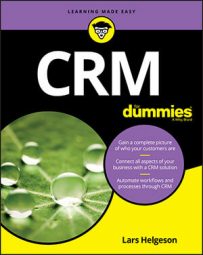CRM isn’t just software. It’s a well-coordinated, company-wide, data-driven system devoted to the high levels of customer engagement and satisfaction that drive growth and profit.
Thinking like CRM
CRM represents a way of thinking, a culture of accountability and teamwork in a company, where everyone contributes to the growth of the business. When done correctly, it revolutionizes the way the entire team works.CRM sometimes has a negative connotation because it can be viewed as another way for management to drain productivity and look over the shoulders of people who would rather not have every minute of their day accounted for. That is CRM done wrong, and when it’s done wrong, people hate it.
Beyond software, CRM is the centerpiece of your organization’s culture. It’s the glue that binds your team together, making it easy for people to get the information they need to do their jobs better. CRM is the environment of collaboration, tracked and managed by people contributing to the company’s growth and success.
CRM creates continuity in an organization. As the company evolves, the record of your interactions with leads and clients becomes an asset. The company becomes more valuable because that intellectual capital that you have worked so hard to build becomes permanent and integral. Information about those relationships and transactions provides the feedback the company needs to know in order to better serve clients.
Acting like CRM
There’s an expression that resonates with organizational teams and helps them understand the value of having everyone on the same page:If it isn’t in the CRM, it didn’t happen.
This expression impresses upon everyone the need for documenting any and all interactions with leads and clients.
As much as a leader can tell his or her team that they have to use their CRM, people resist change. They resist accountability. You need to understand how human psychology plays a role in getting your CRM adopted company-wide. People do things because they want to, so remember to remind your team of the benefits your Complete CRM will bring.
As people have relationships with each other, so do they have relationships with the software they use. You want to create a positive relationship between your team and your CRM right from the beginning.Building two-way relationships
Like any relationship, treat your relationship with your CRM as a two-way street. If people are putting information in, make sure they get valuable information out. This concept is the crux of why most CRM implementations fail. When management doesn’t commit to a CRM, it lets people work within the business without adding data into the system. Some people end up using it; others don’t. When your team chooses to not use your CRM, they break the two-way relationship, which results in fragmented, inconsistent customer experiences.For this two-way relationship to work, everyone must be able to get data out of the CRM — useful data that helps her do her job better. Here are a few examples:
- If you’re a salesperson, you want to know if your leads are opening their emails, visiting your company’s website, filling out forms, and/or talking to customer service.
- If you’re in marketing, you want to know who your most interested leads are and why. Tracing your most effective marketing campaigns helps guide your future expenditures and forecasting.
- If you’re in customer service, you want to know each client’s history. If you’re running an event, you want to know who’s coming and why, and how you can follow up with the attendees and no-shows.
Having a relationship with your relationship management software may seem like an odd concept, but it’s absolutely true. Software by itself is just software. Software lies dormant until someone does something with it.
As the saying goes, “information is power.” The more people work with CRM, the more powerful the CRM becomes. The more powerful the CRM, the more powerful the organization.
Adding a leaderboard to motivate your team
A big part of managing a sales team is encouraging a sense of competition between your salespeople. A leaderboard is a great way to integrate a CRM into your company culture.Leaderboards work by setting certain quotas for members of your team. Salespeople are judged by their ability to meet and exceed their quotas, and if you publicly share their success (or struggle), they’re motivated to work harder and sell better.
Consider using leaderboard software to show everyone in the organization who the best salespeople are. They appreciate the recognition and people see the top performers, which is a motivator to increase sales.


